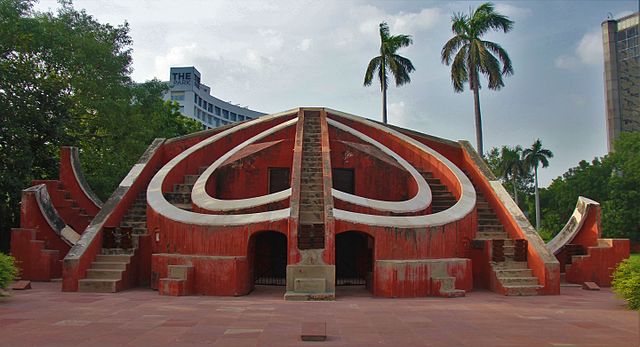Jantar Mantar (The biggest one is in Jaipur)
Sansad Marg, Connaught Place, New Delhi, Delhi 110001
Phone : 011 2336 5358
The Jantar Mantar is located in the modern city of New Delhi. It consists of 13 architectural astronomy instruments. The site is one of five built by Maharaja Jai Singh II of jaipur , from 1724 onwards, as he was given by Mughal emperor Muhammad shah the task of revising the calendar and astronomical tables. There is a plaque fixed on one of the structures in the Jantar Mantar observatory in New Delhi that was placed there in 1910 mistakenly dating the construction of the complex to the year 1710. Later research, though, suggests 1724 as the actual year of construction.
The primary purpose of the observatory was to compile astronomical tables, and to predict the times and movements of the sun, moon and planets. Some of these purposes nowadays would be classified as astronomy.
There are three instruments within the observatory of Jantar Mantar in New Delhi: the Samrat Yantra, the Jayaprakash, and the Misra Yantra.
Samrat Yantra: The Samrat Yantra, or Supreme Instrument, is a giant triangle that is basically an equal hour sundial. It is 70 feet high, 114 feet long at the base, and 10 feet thick. It has a 128-foot-long (39 m) hypotenuse that is parallel to the Earth’s axis and points toward the North Pole. On either side of the triangle is a quadrant with graduations indicating hours, minutes, and seconds. At the time of the Samrat Yantra’s construction, sundials already existed, but the Samrat Yantra turned the basic sundial into a precision tool for measuring declination and other related coordinates of various heavenly bodies.
Jayaprakash Yantra: The Jayaprakash consists of hollowed out hemispheres with markings on their concave surfaces. Crosswires were stretched between points on their rim. From inside the Ram, an observer could align the position of a star with various markings or a window’s edge.
Misra Yantra: The Misra Yantra was designed as a tool to determine the shortest and longest days of the year. It could also be used to indicate the exact moment of noon in various cities and locations regardless of their distance from Delhi – quite remarkable! The Mishra yantras were able to indicate when it was noon in various cities all over the world and was the only structure in the observatory not invented by Jai Singh II.
Source : Wikipedia
http://www.youtube.com/watch?v=SJNjpkGcVZ4
Reviews
Visiting hours : Daily 6.00 AM to 7.00 PM
Entry Fee : Rs.5/- for Indians and Rs.100/- for foreign Nationals.



Rate this article